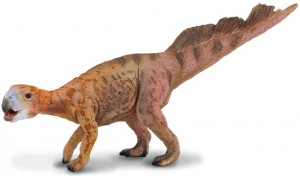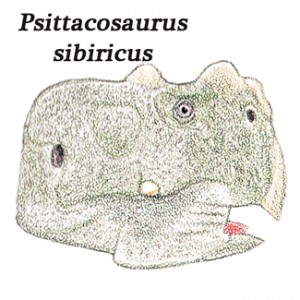Russian Scientists Excavate Psittacosaurus Fossils
New Specimen of Psittacosaurus sibiricus Discovered
If there were prizes given out to the Dinosauria for being the most successful in terms of species known and geographical distribution, then the primitive horned dinosaur Psittacosaurus would very likely be up for an award. To date, something like ten species or so have been named and fossils of these early ceratopsians have been found over a vast area of Asia, from north-eastern China through to central Russia. Our knowledge of psittacosaurs is likely to be increased thanks to the discovery of what is believed to be an almost complete specimen, excavated from Cretaceous-aged sediments near to the village of Shestakovo (Chebulinsky district).
Psittacosaurus Fossils
In a press release from Russian news agencies and the Kemerovo Regional Museum, Olga Feofanova (Director of the Kemerovo Regional Museum), explained that the dinosaur fossil specimen had been discovered at a well-researched and studied fossil dig site that has yielded a number of vertebrate specimens in the past, including a several examples of rare Cretaceous mammal fossils. This particular Psittacosaurus was discovered after three weeks of careful excavation. The fossil material is still entombed in the surrounding rock.
The block of stone was carefully removed and will be stored at the Kemerovo Museum and made ready for display. A spokesperson for the Museum commented that it might take up to six months to extract the fossilised material from the surrounding matrix.
An Image of a Typical Psittacosaurus
Picture credit: Everything Dinosaur
For models and replicas of Early Cretaceous prehistoric animals and other extinct creatures: CollectA Prehistoric Life Models.
The Russian scientists are confident that their specimen represents a Psittacosaurus sibiricus, a species of Psittacosaurus which is known from a complete skull and the majority of the skeleton, found in 120- million-year-old rocks at locations in central Russia and Siberia. This new fossil discovery may prove to be the most complete P. sibiricus fossil found to date.
Olga Feofanova added that the finding of this new fossil, believed to represent an individual dinosaur that was more than two metres long, will make it possible to conduct a comparative analysis with other Psittacosaurus sibiricus fossils to help palaeontologists learn more about how these dinosaurs grew (ontogeny). A number of museums and universities have been examining how psittacosaurs changed as they grew and matured. For example, last year, Everything Dinosaur reported on research conducted by the University of Bristol, the Institute of Vertebrate Palaeontology and Palaeoanthropology (Beijing) and Bonn University which examined how the stance and locomotion of psittacosaurs changed as they got older.
To read more: Psittacosaurs Moving from Four Legs to Two.
An Illustration of P. sibiricus
Picture credit: Paul/Everything Dinosaur
This psittacosaurid had a broad, deep snout and size estimates vary between 1.5 metres and 2.5 metres in length.
With fossil finds all over Asia, these relatively small and lightweight dinosaurs were extremely successful. A number of remarkable fossil finds have been made over the years, back in September 2007, Everything Dinosaur team members reported on a Psittacosaurus fossil discovery that suggested that these dinosaurs looked after their young in collective nurseries.
To read more about this fossil discovery: Dinosaur Nursery Unearthed in China.
It is good to hear about a dinosaur whose fossilised remains will most likely be going on display in a museum quite close to where the fossils were found.



